Abstract
The purpose of this study is to investigate the healing performance of solid capsules made of cement as a basis for manufacturing self-healing capsules that can heal cracks in cementitious composites. The solid capsules were mixed with 5%, 10%, and 15% concentrations on the cement. The self-healing performance of cementitious composites with solid capsules was investigated through three evaluations. First, the mechanical strength-healing performance was evaluated through a re-loading test. Second, the durability-healing performance was evaluated through a permeability test. Finally, the crack-healing performance was examined by observing the crack widths. Through evaluation of the healing performance of the solid capsules, the healing performance of the compressive strength was found to be high when the capsule proportion was 10% and its size was within the range of 300 μm to 850 μm. Furthermore, the splitting tensile strength showed a high healing performance when the capsule proportion mixed was 15% and its size was 850 μm. In the case of the permeability test, a capsule size of 850 μm showed a healing effect greater than 95%. Cracks with a width of up to 200 μm tended to heal using capsules with a size of 600 μm to 850 μm.
1. Introduction
Recently, various studies have been conducted on self-healing technologies in the construction industry. Although self-healing technologies have the disadvantage of incur-ring high initial costs, it has been shown that their economic advantage is greater in the long term, because they can heal cracks on their own [1,2].
Cracks occur in most concrete structures due to a variety of causes, such as shrinkage and mechanical loading, which decrease functionality, accelerate degradation, and reduce the service life and sustainability of the structure [3]. Cracks in a concrete structure constructed with self-healing materials can be healed at an early stage of cracking, which can greatly reduce the time, effort, and cost required for general structural maintenance. In particular, self-healing technology has the potential to repair mechanical damage and cracks in concrete structures effectively, even in difficult-to-access structures [4,5,6]. For example, self-healing repair methods have been applied to an existing subway tunnel to stop water leaking from cracks [7]. Such technologies can enable structures to self-heal and are largely divided into three categories based on the concepts used [8]. The concept of a typical self-healing technology involves natural healing through the rehydration of un-hydrated cement and autonomic healing using organic and inorganic materials, cement-based minerals, and bacteria. This technology can be classified into activated healing using capsules, memory alloys, and glass hollow fibers.
Materials such as minerals [9], bacteria [10,11], superabsorbent polymers (SAPs) [12], and microcapsules [8,13] are being explored for use as self-healing materials. Inorganic materials improve the self-healing capacities of cement-based materials through the hydration of un-hydrated cement [14], the generation of calcium carbonate via the carbonation reaction of Ca2+ [15], or the generation of C-S-H via pozzolanic reactions of fly ash or blast furnace slag [16].
The self-healing phenomenon of concrete using geomaterials occurs mainly due to swelling, expansion, and re-crystallization [9]. When a crack occurs, SAPs absorb the water that comes through the crack and expand to physically block the crack [12]. Bacteria heal cracks through a phenomenon in which CO2 generated by their metabolic activity forms CaCO3 crystals through a reaction with Ca(OH)2 in a hardened cement paste [10,11].
Among these various self-healing concepts, the technology using capsules can include a large amount of self-healing material, and it has the advantage of selectively reacting to the crack [17,18]. Self-healing capsules can be classified into solid capsules (SCs) coated with a film, which is made via agglomeration of the powdery material [19,20], and microcapsules or macro capsules encapsulated using a chemical method [8,21]. Accordingly, the capsule utilization technology can provide self-healing performance by employing a different reaction mechanism depending on the target material, and an appropriate core material phase can be selected [22]. In addition, many systems and techniques have been proposed to heal concrete cracks autonomically, such as modifying concrete by embedding microcapsules or hollow tubes with a suitable healing agent. When a crack occurs and the shell of the capsule or the wall of the tube ruptures, the healing agent is released and reacts in the region of damage to produce new compounds, which seal the crack and/or bond the crack faces together [23].
The use of mineral admixtures as self-healing agents in cement-based composites has been studied extensively. However, if minerals are added directly to the cementitious matrix without any protection, they can immediately react, leading to a decrease in self-healing efficiency with additional side effects on the mechanical properties of cementitious composites. In order to overcome such a problem, several kinds of methods have been proposed. Choi et al. [19] fabricated crack self-healing solid capsules encapsulated with cement powder which can react with water in the event of breaking. Kishi et al. [24] investigated the crack-healing capability of concrete incorporating granules of pozzolanic materials, Portland cement, and some specific admixtures and its feasibility in practice.
Pan pelletization was used to produce pellets from three different powdered minerals as potential healing agents: reactive magnesium oxide (MgO), silica fume, and bentonite. Prototype pellets were then encapsulated in a polyvinyl alcohol (PVA)-based film coating [25]. The impregnation of lightweight aggregates using a liquid self-healing mineral and their subsequent encapsulation in a polymer-based coating layer was suggested as a method for improving the self-healing performance of concrete composites [13].
In recent years, self-healing capsules have been developed that can react to sunlight or moisture without the use of a separate catalyst [26]. Most materials investigated for self-healing technologies are organic materials [27,28], and since the capsule is mixed with the surface coating material, the healing range is limited to the surface layer of the structure. In order to achieve effective self-healing performance, it is advantageous to have the same characteristics as the structure and to be mixed with the cementitious composites constituting the structure. Most cementitious composites are based on inorganic materials. It is therefore expected that the use of inorganic-based materials will have a greater healing effect. Studies on self-healing using inorganic material have been extensively conducted based on expansion-, swelling-, and crystallization-promoting chemicals; however, it is difficult to find examples of encapsulation applications in the literature [29].
Therefore, in this study, a solid-state capsule encapsulating cement powder was prepared as an inorganic material. The solid capsules were prepared at seven different sizes (2400, 1200, 850, 600, 300, 150, and 75 μm) [30]. Furthermore, the solid capsules were mixed with 5%, 10%, and 15% SHC on the cement mass. To investigate the self-healing performance of the solid capsules, three evaluations were conducted. The mechanical characteristics were evaluated through a re-loading test and the durability was evaluated through a permeability test. Finally, the self-healing performance was examined through observations of cracks. The results of this study can be used as a reference for producing solid capsules using other inorganic materials.
2. Experiment Outline
2.1. Experimental Materials
2.1.1. Binder
The cement used in the experiment was ordinary Portland cement (OPC) with a density of 3.15 g/cm3 and a surface area of 3540 cm2/g. Table 1 shows the chemical composition and physical properties of the cement used in the experiment.

Table 1.
Chemical composition and physical properties of ordinary Portland cement.
2.1.2. Fine Aggregate
The fine aggregate used in the experiment was a river sand (RS). Table 2 shows the physical properties of the aggregate used in the experiment.

Table 2.
Physical properties of fine aggregate.
2.1.3. Chemical Admixture
The chemical admixture (ad) used in the experiments was a polycarboxylic acid high-performance water-reducing agent. Table 3 shows the physical properties of chemical admixtures.

Table 3.
Physical properties of chemical admixture.
2.1.4. Solid Capsules
The self-healing solid capsule (SHC) used in the experiments was prepared at seven different sizes (2400, 1200, 850, 600, 300, 150, and 75 μm) [31]. Figure 1 shows the SHC used in the experiment and Figure 2 shows the size and extent of SHC. The healing and core material of SHC is OPC. OPC goes through a granulation process by adding a urethane-based coagulant. After that, in order to mix directly with the mortar formulation, it is essential to coat the core material in order to prevent a prior reaction with the mixing water during the mixing process. In this study, mixing water was blocked by applying liquid rubber on the surface of the core material [31]. Figure 3 shows the state before and after surface coating of the core material. Afterwards, SHC was finally classified according to size. SHC sorted by size was mixed when mixing the mortar. Cementitious composites mixed with SHC were molded to suit each re-load test and water permeability test.
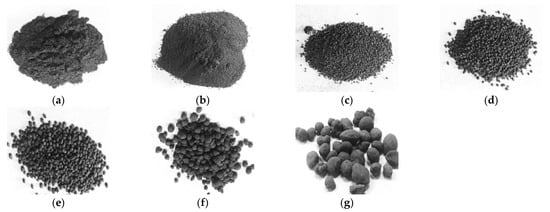
Figure 1.
Type of self-healing solid capsules: (a) 75 µm, (b) 150 µm, (c) 300 µm, (d) 600 µm, (e) 850 µm, (f) 1200 µm, and (g) 2400 µm.
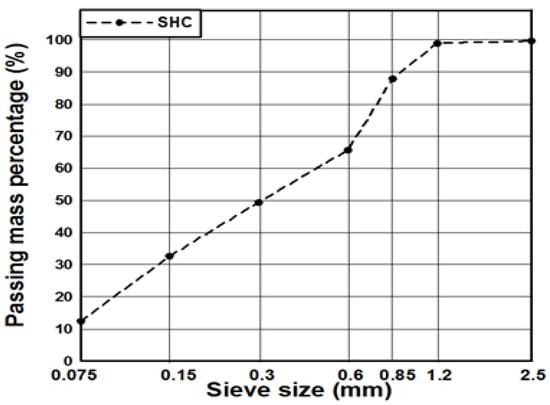
Figure 2.
Size and range of self-healing solid capsules.
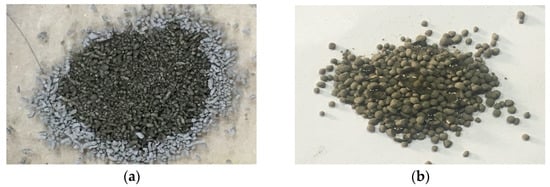
Figure 3.
State with or without surface coating of core material: (a) no surface coating, (b) after surface coating.
2.2. Experimental Plan
SHC blended 4 levels (0, 5, 10, 15%) for cement. The healing performance of the solid capsules was examined using a re-loading test, a permeability test, and observations of cracks. The re-loading test was carried out for compressive strength and splitting tensile strength. Table 4 shows the test variables and evaluation method, and Table 5 shows the mix table.

Table 4.
Experimental parameters and evaluation contents.

Table 5.
Mix of SHC.
2.3. Experimental Method
2.3.1. Re-Loading Test
- (1)
- Compressive strength
The compressive strength test and the re-load test were conducted according to ASTM C349. Figure 4 shows the re-loading test conducted to evaluate the compressive strength. The specimen was a 50 mm × 50 mm × 50 mm cube. The compressive strength test and the re-load test were conducted using a universal testing machine (UTM).
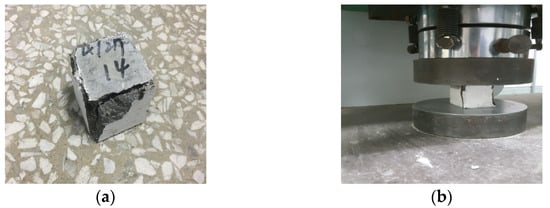
Figure 4.
Compressive strength re-load test: (a) fracture specimen for re-load test, (b) re-load test of fractured specimens after the healing period.
Since there is no special regulation for the re-load test, various cases were analyzed and evaluation was conducted according to its own standards [32,33,34,35,36]. The first was destroyed by applying up to the maximum load of the specimen at 28 days of age, as shown in Figure 3a. Afterwards, the destroyed specimens were cured in water. Then, as shown in Figure 3b, a re-loading test was performed after a three-day healing period.
- (2)
- Splitting tensile strength
The splitting tensile strength test and the re-load test were used according to ASTM C496. A cylindrical specimen of Ø50 × 100 mm was used. Figure 5 shows the splitting tensile strength re-loading test. The splitting tensile strength test and the re-load test were conducted using the same universal testing machine (UTM) for compressive strength evaluation. The splitting tensile strength test and the re-load test were conducted under the same conditions as the compressive strength test and the re-load test.
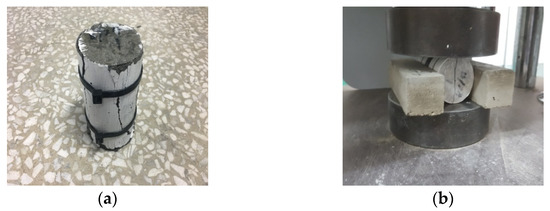
Figure 5.
Splitting tensile strength re-load test: (a) fracture specimen for re-load test, (b) re-load test of fractured specimens after the healing period.
2.3.2. Water Permeability Test
The water permeability test was carried out by attaching a measuring cylinder to the upper part of the specimen where an artificial crack was induced. Then, the measuring cylinder was filled with water and the amount of permeated water was measured. Figure 6 shows the water permeability test. The specimen was a disk Ø50 × 5 mm in size. Specimens with artificial cracks were cured in a water bath for 3 days. After that, the amount of water passing through the crack was measured through a water permeability test. For the water permeability test, the appropriate SHC mixing proportion was selected according to the results of re-loading test.
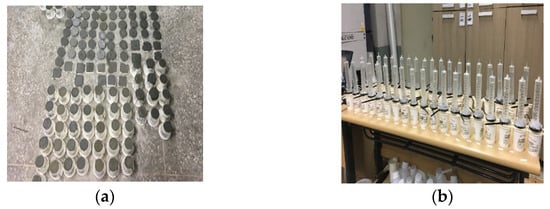
Figure 6.
Water permeability test: (a) specimen production for water permeability test, (b) a view of the water permeability test.
2.3.3. Observation of Cracks
Observation of cracks was performed by making specimens of thin plate type, followed by artificially cracking, and then by observing the crack surface using Video Microscope EGVM 35B. Figure 7 and Figure 8 show the manufacturing process and observation method of the specimen for crack surface observation. The specimen was a disk 50 mm × 50 mm × 5 mm in size.
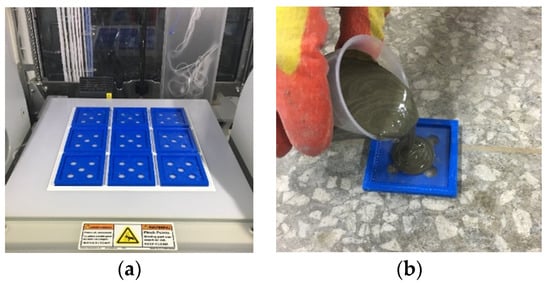
Figure 7.
Fabrication of specimen for observation of crack: (a) mold for disc specimens for crack observation, (b) disc specimen fabrication process.

Figure 8.
Observation of crack: (a) marking of crack area in disc specimens, (b) observation of cracks in disc specimens using a microscope.
The small plate-shaped mold used for crack monitoring was made by hand using 3D printing. Specimens with artificial cracks were cured in a water bath for 3 days. After that, the crack surface of the specimen was monitored. The crack surface was observed at 3 levels (850, 600, and 300 μm) of SHC which showed a large healing effect through the permeability test.
3. Experimental Results and Discussion
3.1. Re-Loading Test
3.1.1. Compressive Strength
Figure 9 shows compressive strength re-loading test results according to the mixing proportion of SHC, and Figure 9d shows the recovery rates of initial strength and re-loading strength. As a result of compressive strength test, the compressive strength tended to decrease with SHC mixing, and then decreased sharply with increasing SHC mixing proportion. This is because the area where the SHC was placed is fragile and cannot sustain the load. Moreover, as the mixing proportion increases, the fragility of this area increases, further decreasing the compressive strength. The compressive strength decreased with decreasing SHC size. The compressive strength of 5% SHC decreased proportionally from 5% to 10% in the range of 2400 μm to 850 μm, and decreased by more than 10% in the case of less than 600 μm. The compressive strength of 75 μm was reduced by up to 30%. The compressive strength of 10% and 15% SHC were similar to those of 5%. The re-loading strength was found to restore strength by approximately 80% in all mixtures containing SHCs compared with the plain specimen, where approximately 30% of the original strength was restored. The healing effect was shown to increase with increasing SHC mixing proportion; however, the healing effect of SHC 15% was equivalent to that of SHC 10%. These results suggest that SHC with a mixing proportion of 10% and a size equal to or greater than 600 μm is more effective in terms of healing efficiency. When considered alone, the healing efficiency was high when SHCs with sizes of 300–850 μm were used. In addition, it was confirmed that there is a natural healing performance even in the plain specimen without SHC. This is because the healing effect is expressed by the un-hydrated cement. In addition, it is expected that the natural healing performance of the plain specimen can be improved through the use of SHC.

Figure 9.
Re-loading test result of compressive strength: (a) SHC 5%, (b) SHC 10%, (c) SHC 15%, (d) recovery level.
3.1.2. Splitting Tensile Strength
Figure 10 shows the splitting tensile strength re-loading test results according to the amount of SHC mixed, and Figure 10d shows the recovery rate of the initial strength and re-loading strength. The splitting tensile strength test showed that the splitting tensile strength was equivalent to that of the compressive strength test. It is considered that the splitting tensile strength decreases for the same reason as the decrease in the compression strength. The splitting tensile strength of specimens at sizes equal to or greater than 600 μm did not show a significant difference. However, the reduction after 300 μm increased by approximately 15% and decreased by approximately 30% at 75 μm. The re-loading strength was restored to approximately 50% only at 850 μm, 600 μm, and 300 μm. At 850 μm with a 15% mixing proportion, the maximum strength recovery was 60% and the Plain was not restored. However, unlike the re-loading test results of the compressive strength, recovery ratios at 5% and 10% SHC were equivalent. The 15% SHC was approximately 20% higher than that of 10%. From these results, it can be concluded that the splitting tensile strength is high at specimens with sizes of 850 μm, 600 μm, and 300 μm and with a mixing ratio of 10% or more. In the case of splitting tensile strength, it was confirmed that the plain specimen also had a natural healing performance, which was same as the compressive strength analysis result. In addition, in the case of compressive strength, there was no significant difference between SHC 10% and SHC 15%. However, unlike the compressive strength, in the case of splitting tensile strength, the recovery level of SHC 15% was large. The reason for this is that the splitting tensile strength depends on the interface, so the recovery level increases.

Figure 10.
Re-loading test result of splitting tensile strength: (a) SHC 5%, (b) SHC 10%, (c) SHC 15%, (d) recovery level.
3.2. Water Permeability
Figure 11 shows the results of the permeability test using SHC 10%. The permeability of general test specimen without cracks was measured to be 8 g, and the crack test specimen plain was measured to be 159 g. When SHC was mixed into the specimens, a healing effect was not observed above 1200 μm. The decrease in permeability owing to the healing effect occurred only when the size was less than 850 μm. The results showed that the healing effect of 850 μm was the most effective for decreasing the permeability. Although the healing effect was relatively small, it was also observed at 600 and 300 μm.

Figure 11.
Test results of water permeability.
These results suggest that there is no curative effect if the SHC is too small or too large. In other words, when the SHC is too small, when the SHC is broken along the interface, the SHC cannot be destroyed and may stick to the interface. Conversely, when the SHC is too large, the volume of the SHC present in the cross-section may be relatively small. Therefore, it was confirmed that there is an optimal size of SHC when only the healing effect is considered.
3.3. Observation of Cracks
Figure 12 shows the observation result of the crack surface. In the plain specimen, the formation of hydrates from cracks at an average crack width of about 40 to 50 μm was observed. However, the cracks were not completely restored. These results show that cement composites have a natural healing effect because they have un-hydrated cement particles. In the case of SHC with a size of 850 μm, crack healing was observed for all cracks except for those with a width of approximately 200 μm. The healing area of the crack surface is similar according to the size, but the healing efficiency of 850 μm and 600 μm is considered to be high. However, these results seem to be related to the natural healing effect rather than the sole effect of SHC. In other words, SHC is expected to improve natural healing performance. However, further analysis is necessary to consider the healing effects of SHC alone. Furthermore, in the case of crack monitoring results, it was confirmed that there was an optimal size of SHC in the results of water permeability.


Figure 12.
Results of observation of crack: (a) plain (initial crack) (b) plain (crack healing), (c) SHC 10%—850 µm (initial crack) (d) SHC 10%—850 µm (crack healing), (e) SHC 10%—600 µm (initial crack) (f) SHC 10%—600 µm, (crack healing), (g) SHC 10%—300 µm (initial crack), (h) SHC 10%—300 µm (crack healing).
4. Conclusions
The results of the healing performance evaluation of solid capsules for the self-healing of crack in cementitious composites were as follows:
- (1)
- The mechanical-healing performance of cement composites according to the different mixing proportions of solid capsules showed that the compressive strength healing efficiency was high when the capsule proportion was 10% and its size was in the range of 300 μm to 850 μm. In case of splitting tensile strength, the healing performance was high when the capsule proportion was 15% and its size was 850 μm.
- (2)
- The decrease rate of the permeability of cement composites according to different proportions of solid capsules was more than 95% when the capsule size was 850 μm. It was also found that healing effects can be expected even at 600 and 300 μm.
- (3)
- It was confirmed that the cracks were healed by the reaction products of the self-healing solid capsules. When using capsule sizes of 850 μm to 600 μm, the crack width tended to heal up to approximately 200 μm.
These results suggest that the optimal capsule healing efficiency can be obtained by selecting an appropriate capsule proportion and size in consideration of the characteristics of the object to which the capsule has to be applied. The solid capsule used in this study needs moisture for the healing reaction. Therefore, the use of solid capsules is suitable for members related to moisture. Therefore, SHC is expected to reduce cracks when added to the mix of structures such as the foundations and piers of offshore structures, tank structures, and waterways. However, it is thought that verification in many fields should be additionally accompanied for practical use.
Author Contributions
Conceptualization, methodology, software, validation, and formal analysis, Y.J.K., Y.W.C. and S.-R.O.; investigation, S.-R.O.; resources, Y.J.K.; writing—original draft preparation, Y.J.K. and S.-R.O.; writing—review and editing, Y.J.K. and S.-R.O.; supervision, Y.W.C.; project administration, Y.W.C.; funding acquisition, Y.W.C. All authors have read and agreed to the published version of the manuscript.
Funding
This research was supported by a grant from Construction Technology Research Program funded by Ministry of Land, Infrastructure, and Transport of Korean government. Grant number 22SCIP-C159062-03.
Institutional Review Board Statement
Not applicable.
Informed Consent Statement
Not applicable.
Data Availability Statement
Not applicable.
Conflicts of Interest
The authors declare no conflict of interest.
References
- Schlangen, E.; Sangadji, S. Addressing Infrastructure Durability and Sustainability by Self Healing Mechanisms-Recent Advances in Self Healing Concrete and Asphalt. Procedia Eng. 2013, 54, 39–57. [Google Scholar] [CrossRef]
- An, E.J.; Shin, M.S. Healing Mechanisms and Assessment Techniques of Self-healing Concrete. Proc. Korea Concr. Inst. 2022, 26, 477–479. [Google Scholar]
- De Belie, N.; Gruyaert, E.; Al-Tabbaa, A.; Antonaci, P.; Baera, C.; Bajare, D.; Darquennes, A.; Davies, R.; Ferrara, L.; Jefferson, T.; et al. A review of self-healing concrete for damage management of structures. Adv. Mater. Interf. 2018, 5, 1800074. [Google Scholar] [CrossRef]
- De Rooij, M.R.; Schlangen, E. Self-Healing Phenomena in Cement-Based Materials. In State-of-the-Art Report of RILEM Technical Committee 221-SHC; Springer: Cham, Switzerland, 2011. [Google Scholar]
- Ferrara, L.; Van Mullem, T.; Alonso, M.C.; Antonaci, P.; Borg, R.P.; Cuenca, E.; Jefferson, A.; Ng, P.L.; Peled, A.; Roig-Flores, M.; et al. Experimental characterization of the self-healing capacity of cement-based materials and its effects on the material performance: A state of the art report by COST Action SARCOS WG2. Constr. Build. Mater. 2018, 167, 115–142. [Google Scholar] [CrossRef]
- Mihashi, H.; Nishiwaki, T. Development of engineered self-healing and self-repairing concrete-state-of-the-art report. J. Adv. Concr. Technol. 2012, 10, 170–184. [Google Scholar] [CrossRef]
- Murakami, T.; Ahn, T.H.; Hashimoto, T.; Ogura, N.; Kishi, T. A study on the new water repair method for subway tunnels using crack self-healing repair materials. In Proceedings of the 5th International Conference on Self-Healing Materials, Durham, NC, USA, 22–24 June 2015. [Google Scholar]
- Tatyana, N.; Kim, D.J.; Lars, T.P.; Søren, K. Microcapsule-based Self-Healing Anticorrosive Coatings: Capsule Size, Coating Formulation, and Exposure Testing. Prog. Org. Coat. 2012, 75, 309–318. [Google Scholar]
- Ahn, T.H.; Kishi, T. Crack self-healing behavior of cementitious composites incorporating various mineral admixtures. J. Adv. Concr. Technol. 2010, 8, 171–186. [Google Scholar] [CrossRef]
- Van Tittelboom, K.; De Belie, N.; De Muynck, W.; Verstraete, W. Use of bacteria to repair cracks in concrete. Cem. Concr. Res. 2010, 40, 157–166. [Google Scholar] [CrossRef]
- Jonkers, H.M.; Thijssen, A.; Muyzer, G.; Copuroglu, O.; Schlangen, E. Application of bacteria as a self-healing agent for the development of sustainable concrete. Ecol. Eng. 2010, 36, 230–235. [Google Scholar] [CrossRef]
- Lee, H.; Wong, H.; Buenfeld, N. Self-sealing of cracks in concrete using superabsorbent polymers. Cem. Concr. Res. 2016, 79, 194–208. [Google Scholar] [CrossRef]
- Alghamri, R.; Kanellopoulos, A.; Al-Tabbaa, A. Impregnation and encapsulation of lightweight aggregates for self-healing concrete. Constr. Build. Mater. 2016, 124, 910–921. [Google Scholar] [CrossRef]
- Huang, H.; Ye, G.; Damidot, D. Characterization and quantification of self-healing behaviors of microcracks due to further hydration in cement paste. Cem. Concr. Res. 2013, 52, 71–81. [Google Scholar] [CrossRef]
- Van Tittelboom, K.; Gruyaert, E.; Rahier, H.; De Belie, N. Influence of mix composition on the extent of autogenous crack healing by continued hydration or calcium carbonate formation. Constr. Build. Mater. 2012, 37, 349–359. [Google Scholar] [CrossRef]
- Van Tittelboom, K.; De Belie, N. Autogenous healing of cracks in cementitious materials with varying mix compositions. In Proceedings of the 2nd International Conference on Self-Healing Materials, Chicago, IL, USA, 28 June–1 July 2009. [Google Scholar]
- Hunger, M.; Entrop, A.G.; Mandilaras, I.; Brouwers, H.J.H.; Founti, M. The Behavior of Self-Compacting Concrete Containing Micro-Encapsulated Phase Change Materials. Cem. Concr. Compos. 2009, 31, 731–743. [Google Scholar] [CrossRef]
- Memon, S.A.; Cui, H.Z.; Zhang, H.; Xing, F. Utilization of Macro Encapsulated Phase Change Materials for the Development of Thermal Energy Storage and Structural Lightweight Aggregate Concrete. Appl. Energy 2015, 139, 43–55. [Google Scholar] [CrossRef]
- Choi, Y.W.; Oh, S.R.; Choi, B.K. A study on the manufacturing properties of crack self-healing capsules using cement powder for addition to cement composites. J. Adv. Mater. Sci. Eng. 2017, 2017, 5187543. [Google Scholar] [CrossRef]
- Oh, S.R.; Choi, Y.W.; Kim, Y.J. Effect of cement powder based self-healing solid capsule on the quality of mortar. Const. Build. Mater. 2019, 214, 574–580. [Google Scholar] [CrossRef]
- Qureshi, T.S.; Kanellopoulos, A.; Al-Tabbaa, A. Encapsulation of expansive powder minerals within a concentric glass capsule system for self-healing concrete. Constr. Build. Mater. 2016, 121, 629–643. [Google Scholar] [CrossRef]
- Mostavi, E.; Asadi, S.; Hassan, M.M.; Alansari, M. Evaluation of self-healing mechanisms in concrete with double-walled sodium silicate microcapsules. J. Mater. Civ. Eng. 2015, 27, 04015035. [Google Scholar] [CrossRef]
- Li, V.C.; Herbert, E. Robust self-healing concrete for sustainable infrastructure. J. Adv. Concr. Technol. 2012, 10, 207–218. [Google Scholar] [CrossRef]
- Kishi, T.; Koide, T.; Ahn, T.H. Effect of granules on the workability and the recovery of water tightness of crack self-healing concrete. J. Cer. Proc. Res. 2015, 16, 63–73. [Google Scholar]
- Alghamri, R.; Kanellopoulos, A.; Litina, C.; Al-Tabbaa, A. Preparation and polymeric encapsulation of powder mineral pellets for self-healing cement based materials. J. Const. Build. Mater. 2018, 186, 247–262. [Google Scholar] [CrossRef]
- Kim, P.S.; Jo, C.K.; Ju, T.H.; Choi, Y.C.; Lee, J.K. Preparation and Thermal Characteristics of Microencapsulated PCM for None Supercooling Phenomenon. In Proceedings of the Korean Society for Energy Engineering Kosee Conference, Daejeon, South Korea, 27 November 2003. [Google Scholar]
- Song, Y.K.; Jo, Y.H.; Lim, Y.J.; Cho, S.Y.; Yu, H.C.; Ryu, B.C.; Lee, S.I.; Chung, C.M. Sunlight-induced Self-Healing of a Microcapsule-type Protective Coating. ACS Appl. Mater. Interfaces 2013, 5, 1378–1384. [Google Scholar] [CrossRef] [PubMed]
- Wang, X.; Xing, F.; Zhang, M.; Han, N.; Qian, Z. Experimental Study on Cementitious Composites Embedded with Organic Microcapsules. Materials 2013, 6, 4064–4081. [Google Scholar] [CrossRef] [PubMed]
- Blaiszika, B.J.; Sottos, N.R.; White, S.R. Nanocapsules for self-healing materials. Compos. Sci. Technol. 2008, 68, 978–986. [Google Scholar] [CrossRef]
- Ahn, T.H.; Morita, M.; Koide, T. Field Test of Self-Healing Concrete on the Recovery of Water Tightness to Leakage through Cracks. In Proceedings of the 3rd International Conference on Self-Healing Materials, Bath, UK, 27–29 June 2011; pp. 297–298. [Google Scholar]
- Choi, Y.W.; Oh, S.R.; Choi, B.K. An Experimental Study on the Manufacturing Properties of Solid Capsules for Mixing Cementitous Composite Materials for Self-Healing of Crack. MATEC Web Conf. 2017, 138, 03005. [Google Scholar] [CrossRef][Green Version]
- Wang, C.; Xiao, J.; Liu, W.; Ma, Z. Unloading and reloading stress-strain relationship of recycled aggregate concrete reinforced with steel/polypropylene fibers under uniaxial low-cycle loadings. Cem. Concr. Compos. 2022, 131, 104597. [Google Scholar] [CrossRef]
- Qureshi, T.; Kanellopoulos, A.; Al-Tabbaa, A. Autogenous self-healing of cement with expansive minerals-I: Impact in early age crack healing. J. Constr. Build. Mater. 2018, 192, 768–784. [Google Scholar] [CrossRef]
- Qureshi, T.; Kanellopoulos, A.; Al-Tabbaa, A. Autogenous self-healing of cement with expansive minerals-II: Impact of Age and the Role of Optimised Expansive Minerals in Healing Performance. J. Constr. Build. Mater. 2019, 194, 266–275. [Google Scholar] [CrossRef]
- Huang, Y.; Guan, Y.; Wang, L.; Zhou, J.; Ge, Z.; Hou, Y. Characterization of Mortar Fracture Based on Three Point Bending Test and XFEM. Int. J. Pavement Res. Technol. 2018, 11, 339–344. [Google Scholar] [CrossRef]
- Feiteira, J.; Gruyaert, E.; De Belie, N. Self-Healing of Moving Cracks in Concrete by Means of Encapsulated Polymer Precursors. J. Constr. Build. Mater. 2016, 102, 671–678. [Google Scholar] [CrossRef]
Publisher’s Note: MDPI stays neutral with regard to jurisdictional claims in published maps and institutional affiliations. |
© 2022 by the authors. Licensee MDPI, Basel, Switzerland. This article is an open access article distributed under the terms and conditions of the Creative Commons Attribution (CC BY) license (https://creativecommons.org/licenses/by/4.0/).